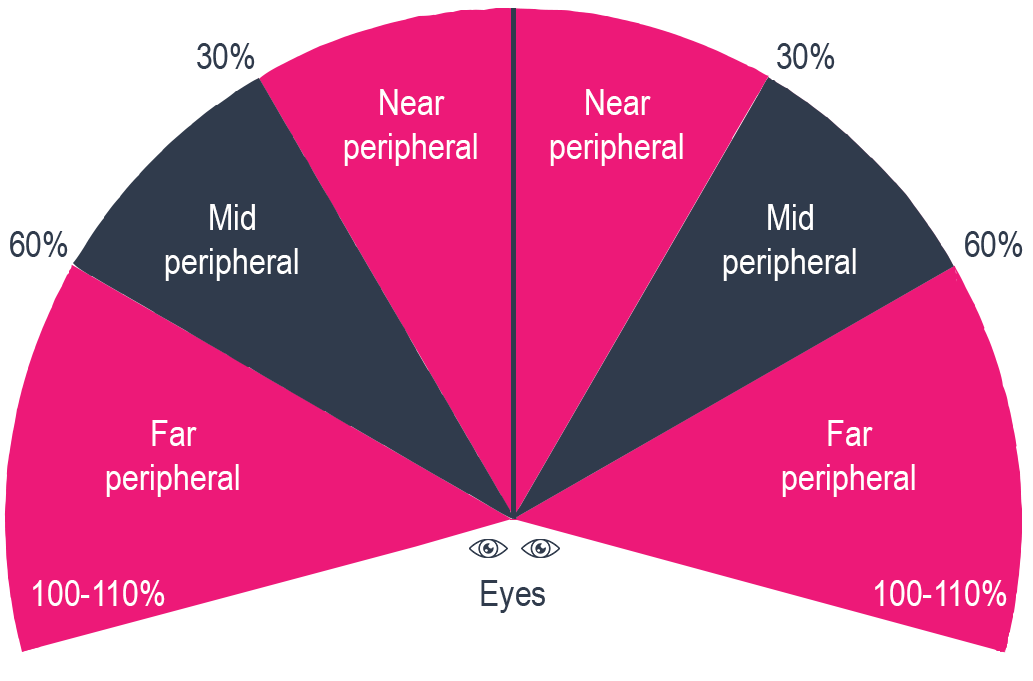
The ‘field of view’ of safety goggles
An attribute not be overlooked
By Hugo Corstjens – Consulent in health & beauty and founder of Novigo+
and Stefaan Vanhalle – R&D Manager STAXS®
Various industries and organisations, such as the European and US agencies ‘Occupational Safety and Health Administration’ (OSHA), foster a safe and healthy occupational environment. One of the instruments to achieve this goal is the promotion of personal protective equipment (PPE). The PPE manufacturer must not only develop products that protect according to well-defined specifications, but also consider ergonomics and comfort in their design and the ease with which a PPE can be maintained or replaced. In this paper, we discuss a PPE property, more specifically the ‘field of view’ (FoV) of safety goggles.
Eye-protection and PPE compliance
Although the importance of a safe working environment is recognised, compliance with PPE rules and guidelines requires constant attention and effort from all stakeholders. According to a recent literature review by Kyriakaki et al. (2021), many eye injuries result from occupational activities and high-risk occupations include welding, farming, construction and manufacturing.
However, PPE is also critical for workers in controlled environments. The demand for and use of PPE has increased dramatically in hospital settings since the start of the COVID-19 pandemic, as a way of preventing the transmission and spread of the virus.
PPE is used in laboratories in various disciplines, where PPE protects the wearer and colleagues against mechanical risks, exposure to radiation and the harmful effects of chemicals. An additional function can be found in clean rooms, where the prevention of contamination of the products being manufactured is crucial. The number of occupational chemical injuries might be rather low (Lurati, 2015), but they can be severe and require immediate intervention. Numerous accidents occur due to the lack or incorrect use of PPE.
Eye injuries are no exception and it is estimated that 90% of eye accidents can be prevented by using the appropriate PPE (Kaiti et al., 2020).
PPE impacts physical and mental well-being and performance
Notwithstanding the indisputable importance of eye protection, there are multiple reasons employees may disregard it. Recent studies of frontline healthcare providers during the COVID-19 crisis shed some light on PPE compliance. Frequently reported PPE related discomforts are headaches (79% of respondents), skin pressure injuries (66%), dizziness (49%), adverse vision (27%) and fatigue (16%) (Duan et al., 2020; Xiao-huan et al., 2020; Swaminathan et al., 2020). Besides, these studies report detrimental effects on well-being, such as a general increase in mental stress, anxiety (12%), insomnia (7%) and depression (6%).
It should therefore come as no surprise that these symptoms have a negative impact on clinical performance and productivity. According to those surveyed, this is due, among other things, to reduced dexterity and impaired vision. The study by Xiao-Huan et al. (2020) is of particular interest as it specifically examines the effects of safety goggles on the health and work status of nurses during COVID-19 management. Approximately 10% of the participants report that, as a result of wearing goggles, they encountered unsafe situations where viral infection or transmission was possible. In addition, about 20% of the respondents report that they had made a medical error, defined as an unsuccessful clinical procedure such as unsuccessful venipuncture or medication errors, which can be associated with goggle-related discomforts.
Despite the indisputable benefits of goggles in terms of eye protection, these studies indicate that these work-related conditions can create unsafe situations for nurses and patients alike. It can be assumed that goggle-associated issues may also apply in other controlled environments, including clean rooms. It is of primary importance to design protective eyewear that meets the needs of the users, so that all barriers that hamper the wider acceptance of these PPEs are removed.
Definition of Field of View (FoV)
|
It has previously been reported that fogging and scratching are two important obstacles to the use of protective eyewear (Lombardi et al., 2009). Solutions in the form of anti-condensation coatings and treatments and designs with improved ventilation capacities on the one hand, and hard coatings with specific material choices and clear guidelines for cleaning on the other, have already been developed for this purpose. Here we would like to discuss another feature of goggles, namely the ‘field of view’ (FoV). The visual field is the width of the area that a person’s eyes can see when they are focussed on a central point. For healthy people, this is typically around 200° to 220° in a horizontal plane, as illustrated in figure 1.
Fig. 1 Regions in the peripheral vision. Image modified from Wikimedia Commons, author Zyxwv99 (https://commons.wikimedia.org/wiki/File:Peripheral_vision.svg), https://creativecommons.org/licenses/by- sa/4.0/legalcode.
|
The term "field of view" is used in the sense of a restriction on what can be seen through external devices, such as when wearing spectacles, a VR-headset, or goggles. The most appropriate FoV depends on the task at hand. The FoV of binoculars varies depending on the magnification but is typically around 7°. For VR headsets, a typical FoV is around 50° (Lynn et al., 2020). The minimal FoV requirements for sports safety eyewear depend on the discipline. For squash and rugby, for example, a minimum value of 160° is reported, although a higher value of 180° is recommended (Dain, 2016; "Goggles Performance Specification | World Rugby", 2021). Our understanding of the distribution of visual attention when planning interactions with objects, both within and outside the field of vision, is complex (Lavoie et al. 2018) and beyond the scope of this article. It should be noted, however, that according to the 'two-stream hypothesis' (Goodale 2011), there is an anatomical and functional difference between visual information that passes through the ventral and dorsal streams. The ventral pathway, characterised by high resolution and object identification, is also referred to as “vision-for-perception”. The dorsal pathway results in less detail and is more focused on spatial location and movement and is therefore called ‘vision-for-action’. According to this hypothesis, both pathways are associated with foveal (central part of our vision with the highest visual acuity) and peripheral vision (perceiving movement and obtaining a general overview), respectively. The role of peripheral vision in everyday tasks, such as walking and driving, is discussed in a review by Vater et al. (2022). The existence of both pathways implies that a restriction of the FoV goes beyond a simple reduction in the field of view but also has a potential impact on specific functions of our vision. |
Reduced FoV affects task performance
|
Peripheral vision impairment is believed to affect physical performance. Conversely, an efficient peripheral field of view can contribute to performance in various sports, including most ball sports, skiing, motor racing, etc. |
Another study measured the effect of a FoV restriction on visual scanning behaviour while performing various mobility activities such as walking, cycling and crossing a street. (Postuma et al. 2025) A FoV restriction to 90° was associated with more horizontal head movements with greater amplitudes and a reduction in horizontal eye position towards the peripheral areas. This suggests a compensatory mechanism by making more and, above all, larger head movements, but obtaining the necessary visual information can still be challenging under these conditions. |
Conclusion
Compliance with the use of safety glasses in controlled and high-risk environments must be encouraged and supported. Based on scientific studies, it can be concluded that limiting the FoV has a significant effect on people's visual performance and can therefore negatively influence certain actions. With regard to persons working in laboratories and cleanrooms, we argue that the field of view of safety glasses is a relevant factor, whereby a wider field of view contributes to the comfort, safety and quality of task performance for the user. The FoV of such glasses must therefore be taken into account in the decision-making process when selecting and purchasing this personal protective equipment.
Your step-by-step decision checklist
Got all the mopping techniques down? Use this handy checklist to consider all options when it comes to mops, and find out what works best for your controlled environment!References
-
Arthur, K. (2000). Effects of Field of View on Performance with Head-Mounted Displays (Doctor of Philosophy in the Department of Computer Science). University of North Carolina at Chapel Hill.
-
Berg, W., & Killian, S. (1995). Size of the Visual Field in Collegiate Fast-Pitch Softball Players and Nonathletes. Perceptual And Motor Skills, 81(3_suppl), 1307-1312. https://doi.org/10.2466/pms.1995.81.3f.1307
-
Dain, S. (2016). Sports eyewear protective standards. Clinical And Experimental Optometry, 99(1), 4-23. https://doi.org/10.1111/cxo.12349
-
Duan, X., Sun, H., He, Y., Yang, J., Li, X., Taparia, K., & Zheng, B. (2020). Personal Protective Equipment in COVID-19: Impacts on Health Performance, Work-Related Injuries, and Measures for Prevention.Journal Of Occupational & Environmental Medicine, 63(3), 221-225. https://doi.org/10.1097/jom.0000000000002123
-
Goggles Performance Specification | World Rugby. World.rugby. (2021). Retrieved 17 June 2021, from https://www.world.rugby/the-game/playerwelfare/equipment/specifications/goggles.
-
Goodale MA. Transforming vision into action. Vision Res. 2011 Jul 1;51(13):1567-87. doi: 10.1016/j.visres.2010.07.027.
-
Kaiti, R., Shyangbo, R., Paudel, B., & Mishra, A. (2020). Personal Protective Equipment for Occupational Safety and Ocular Health - A Review. EC Ophthalmology, 11.7, 61-66.
-
Kauffman, D., Clark, J., & Smith, J. (2014). The influence of sport goggles on visual target detection in female intercollegiate athletes. Journal Of Sports Sciences, 33(11), 1117-1123. https://doi.org/10.1080/02640414.2014.987156
-
Kyriakaki, E., Symvoulakis, E., Chlouverakis, G., & Detorakis, E. (2021). Causes, occupational risk and socio-economic determinants of eye injuries: a literature review. Medicine And Pharmacy Reports, 94(2), 131-144. https://doi.org/10.15386/mpr-1761
-
Lavoie EB, Valevicius AM, Boser QA, Kovic O, Vette AH, Pilarski PM, Hebert JS, Chapman CS. Using synchronized eye and motion tracking to determine high-precision eye-movement patterns during object-interaction tasks. J Vis. 2018 Jun 1;18(6):18. doi: 10.1167/18.6.18.
-
Lombardi, D., Verma, S., Brennan, M., & Perry, M. (2009). Factors influencing worker use of personal protective eyewear. Accident Analysis & Prevention, 41(4), 755-762. https://doi.org/10.1016/j.aap.2009.03.017
-
Lurati, A. (2015). Occupational-Related Chemical Injuries. Workplace Health & Safety, 63(7), 284-287. https://doi.org/10.1177/2165079915576924
-
Lynn, M., Luo, G., Tomasi, M., Pundlik, S., & E. Houston, K. (2020). Measuring Virtual Reality Headset Resolution and Field of View: Implications for Vision Care Applications. Optometry And Vision Science, 97(8), 573-582. https://doi.org/10.1097/opx.0000000000001541
-
Postuma EMJL, Cornelissen FW, Pahlevan M, Heutink J, de Haan GA. Reduced field of view alters scanning behaviour. Virtual Real. 2025;29(2):55. Doi: 10.1007/s10055-025-01125-0.
-
Swaminathan, R., Mukundadura, B., & Prasad, S. (2020). Impact of enhanced personal protective equipment on the physical and mental well-being of healthcare workers during COVID-19. Postgraduate Medical Journal, postgradmedj-2020-139150. https://doi.org/10.1136/postgradmedj-2020-139150
-
Toet, A., Jansen, S., & Delleman, N. (2008). Effects of field-of-view restriction on manoeuvring in a 3-D environment. Ergonomics, 51(3), 385-394. https://doi.org/10.1080/00140130701628329
-
Vater C, Wolfe B, Rosenholtz R. Peripheral vision in real-world tasks: A systematic review. Psychon Bull Rev. 2022 Oct;29(5):1531-1557. doi: 10.3758/s13423-022-02117-w.
-
Xiao-huan, H., Yan-ru, F., Gao-ming, L., Xiao-jiao, P., Ting, C., & Ya-li, Z. et al. (2020). The impact of goggle-associated harms to health and working status of nurses during management of COVID-19. https://doi.org/10.1101/2020.05.11.20094854

